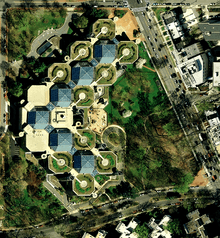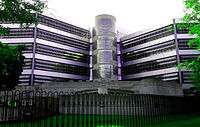Intelsat headquarters
| 3400 International Drive | |
|---|---|
|
Intersection of two pods at an atrium | |
| Alternative names | Intelsat Headquarters |
| General information | |
| Type | Corporate headquarters |
| Architectural style | High-tech |
| Address | 3400 International Drive, NW |
| Town or city | Washington |
| Coordinates | 38°56′33″N 77°03′48″W / 38.9425°N 77.063333°WCoordinates: 38°56′33″N 77°03′48″W / 38.9425°N 77.063333°W |
| Current tenants | Intelsat |
| Groundbreaking | July 20, 1982 |
| Completed | 1984, 1988 |
| Dimensions | |
| Other dimensions | 14 pods[1] |
| Technical details | |
| Floor count | 7 |
| Floor area | 917,000 sq ft (85,200 m2)[2] |
| Design and construction | |
| Architect | John Andrews[3] |
| Architecture firm | John Andrews International and Notter Finegold & Alexander |
| Civil engineer | Richard Strong[4] |
3400 International Drive (also known as Intelsat Headquarters) is an office complex in the North Cleveland Park neighborhood of Washington, D.C. by the Van Ness metro station designed by the Australian architect John Andrews[5] and built by Gilbane Building Company. Formerly used as the U.S. headquarters of the International Telecommunications Satellite Organization (Intelsat), it is known for its futuristic, high-tech architecture.
Structure
John Andrews won the 1980 International Union of Architects international competition to design the complex.[6] The competition had taken place in 1979 with nearly 100 firms from 23 countries competing for the contract to design the complex.[7][8] Ground was broken on the project on July 20, 1982 in a rather unusual manner.[8] Using a network of four satellites and five earth stations, a signal was radioed around the world two times before it triggered a pre-set explosion at the building site.[8] The complex was built in two phases, with Phase I being completed first in 1984 and Phase II following in 1988.[9] While Andrews' contribution was positively cited as that of a creative professional,[10] the project was marred by the embezzlement of five million dollars by Intelsat's director general and deputy.[11]

The complex consists of fourteen interconnected rectangular "pods" clustered in groups of four around taller glass and stainless steel atria.[8] The circular stairwells external to the pods are constructed of glass bricks and concrete.[12] Unusual for the time, the design incorporate environmentally conscious elements that contribute to energy efficiency, such as the use of tinted-glass sunscreens and the open-air atria that admit sunlight while reflecting direct sun.[8] Also, the complex incorporates interior and exterior water features for cooling and terraced roof gardens to complement the large trees preserved by the site plan.[8]
While the building is 917,000 square feet (85,200 m2), only 546,000 sq ft (50,700 m2) is usable office space, with the remainder being taken up by the lengthy corridor down the center of the building, the atria, and other public spaces.[13]
Intelsat was the initial occupant, but after its privatization in 1999[14] and its later mergers with PanAmSat, COMSAT and parts of Loral,[15] its continued presence at the site has been uncertain.[16] This is partially as it is looking for a smaller complex.[17] The embassies of Cameroon, Honduras, and Monaco are currently housed in the building. Other occupants have included the embassies of Belize, Botswana, and Swaziland and WJLA Channel 7.[13]
Reception
Andrews said his design expressed "a spirit of openness, of optimism, of faith in cooperation between peoples and groups of people, and the use of modern technology."[7] However, since its construction, reception has been mixed. Some consider it "a Connecticut Avenue landmark and a must-see for futurists touring the nation’s capital"[18] because of its unique high-tech design and energy efficiency.[19] Early in its existence, it was noted as being a positive repudiation of architectural conservatism,[12] however, its style was not duplicated and therefore it stands out from the surrounding city.[20]
Other critics also note that it does not interact well with the surrounding buildings and add that it can be difficult for visitors to find the entrance given its odd shape and placement.[4] As of 2005 it had been studied by the Historic Preservation Section of the D.C. Office of Planning as a potential landmark of Modern architecture,[21] but a 2011 architectural-historical review of the area as part of the University of the District of Columbia's student center construction planning found that Intelsat was not old enough for landmark status and was a "visual shock" to the neighborhood, given its arguably inappropriate design and sitting for an urban area.[22] The review did indicate that this opinion could change as the building aged further.[12]
References
- ↑ CBRE (November 28, 2011). "3400 International Drive NW - INTELSAT Bldg" (PDF). Showcase.com. CoStar Realty Information, Inc. Retrieved May 15, 2012.
- ↑ Spector, Phillip L. (December 21, 2011). "Form S-4 Registration Statement Under The Securities Act of 1933: Intelsat Jackson Holdings S.A.". EDGAR. Intelsat S.A. Retrieved May 15, 2012.
- ↑ Maccol, Robert; Australian Information Service (1980). "Portrait of John Andrews examining a model of the proposed Intelsat building with his partners, Mr John Simpson, centre, and Mr Peter Courtney, 1980" (photograph). National Library of Australia. Retrieved May 15, 2012.
- 1 2 Kaplan, Sam Hall (June 9, 1985). "New and Old Monumental Sights". Los Angeles Times. Retrieved May 12, 2012.
- ↑ Drew, Philip (May–June 2000). "Flashback: John Andrews in America". Architecture Australia. Architecture Media. Retrieved May 15, 2012.
- ↑ "International Competitions Approved by the UIA Between 1975 and 1995". International Competitions. International Union of Architects. Retrieved May 15, 2012.
- 1 2 "10th Annual Wine Expo". Food and Wine Access. Australia America Association. October 23, 1999. Retrieved May 15, 2012.
- 1 2 3 4 5 6 Kollist, Ingrid (1982). Saft, Stephen A., ed. "Ground Broken for Intelsat Headquarters" (PDF). COMSAT. Washington, D.C.: Communications Satellite Corporation. 10: 6. Retrieved May 15, 2012.
- ↑ Cox News Service (April 20, 1987). "Grand Jury Probes Intelsat Payments". Orlando Sentinel. Tribune Newspaper. Retrieved May 12, 2012.
- ↑ Day, Norman (April 7, 1982). "Andrews uses the logic of a workman". The Age. p. 10. Retrieved May 12, 2012.
- ↑ Tucker, Elizabeth (February 19, 1987). "Satellite Group Report: $5M Diverted". The Washington Post. p. 1A. Retrieved May 12, 2012.
- 1 2 3 Deferrari, John (May 11, 2012). "Curious Capital Architecture: Unusual Buildings of the District of Columbia". AIArchitect. The American Institute of Architects. Retrieved May 15, 2012.
- 1 2 Mazzucca, Tim (December 5, 2005). "Intelsat Building attracts secret plans for its future". Washington Business Journal. American City Business Journals. Retrieved May 12, 2012.
- ↑ Conciatore, Jacqueline (2010). "Intelsat Global Svc Corp". Aol Yellow Pages. AOL Inc. Retrieved May 15, 2012.
- ↑ Pearlstein, Steven (August 18, 2006). "Sweet Deals Buried Intelsat in Debt". The Washington Post. Retrieved May 12, 2012.
- ↑ Sernovitz, Daniel J. (March 26, 2012). "Intelsat weighing D.C.-area relocation". Washington Business Journal. American City Business Journals. Retrieved May 12, 2012.
- ↑ Sernovitz, Daniel J. (March 27, 2012). "Intelsat in the market for space, again". Washington Business Journal. American City Business Journals. Retrieved May 12, 2012.
- ↑ Tytla, Andrew (August 21, 2006). "Intelsat Building for Sale". Really Rocket Science. Retrieved May 15, 2012.
- ↑ Stanton, Meredith (November 2, 2009). Travaglini, Alexia, ed. Frommer's Washington D.C. Day by Day (guidebook) (Second ed.). Hoboken: Wiley Publishing, Inc. p. 43. ISBN 978-0470497609. OCLC 646833916. Retrieved May 15, 2012.
- ↑ Forgey, Benjamin (January 22, 2000). "Urban Squeeze On the Avenue". The Washington Post. p. C01. Retrieved May 12, 2012.
- ↑ Wright, Gwen; Sue Edwards (July 1, 2005). "Worksession on Public Hearing (Preliminary) Draft Amendment to the Approved and Adopted Master Plan for Historic Preservation: COMSAT LAboratories, 22300 Comsat Drive, Clarksburg" (PDF) (letter). The Maryland-National Capital Park and Planning Commission. Retrieved May 15, 2012.
- ↑ Adams, Anne H. (October 6, 2011). "University of the District of Columbia Student Center" (PDF) (letter). Goulston & Storrs. Retrieved May 15, 2012.
